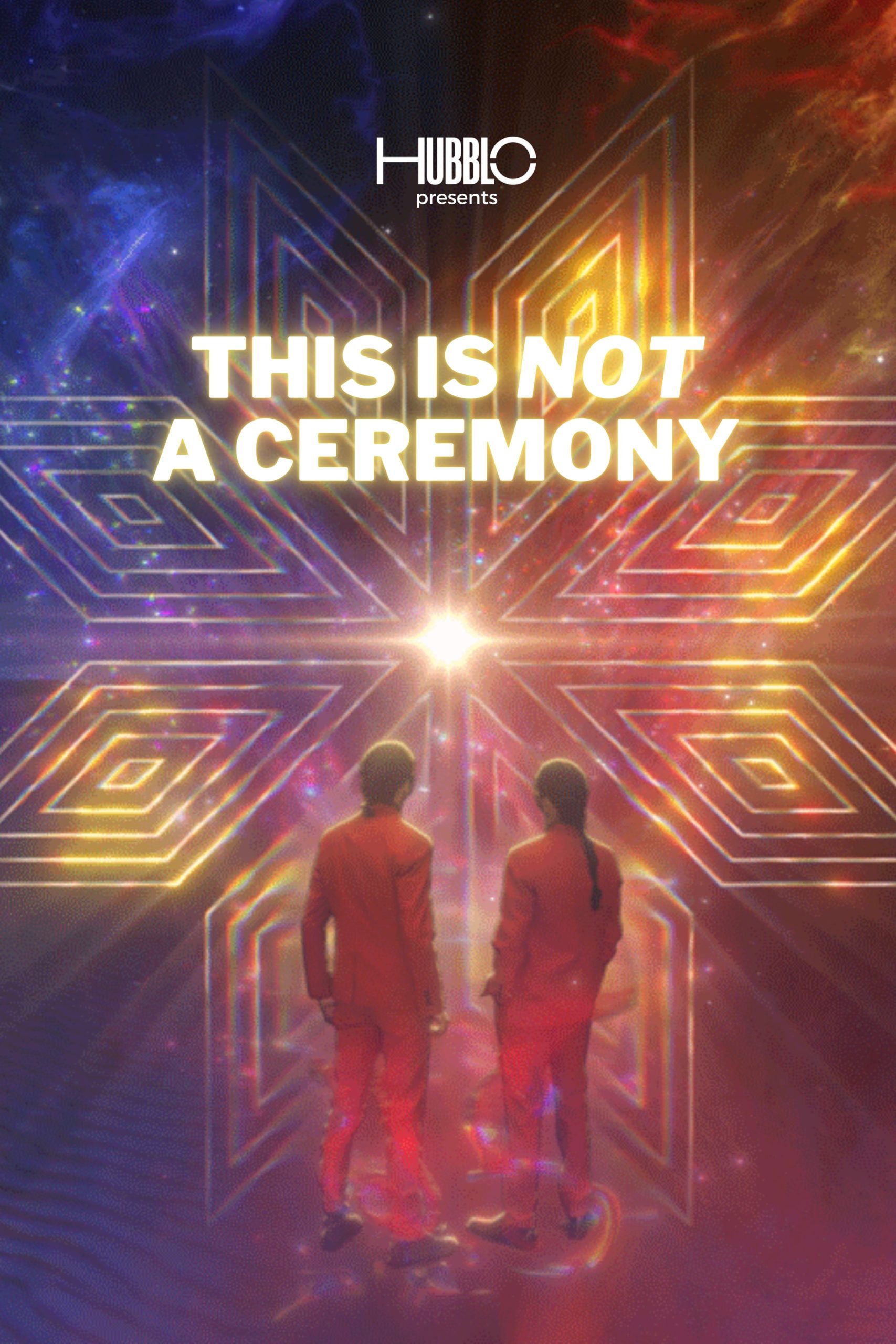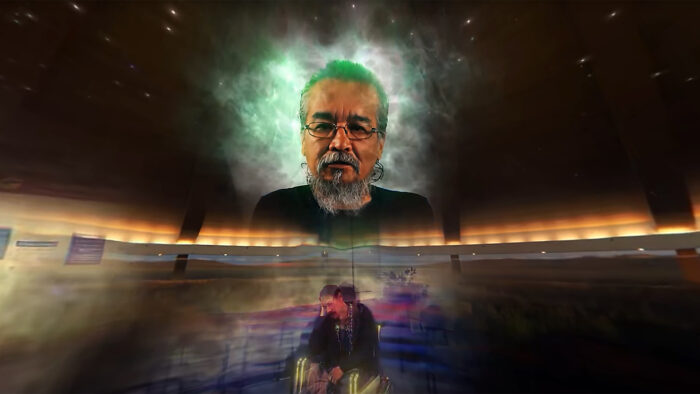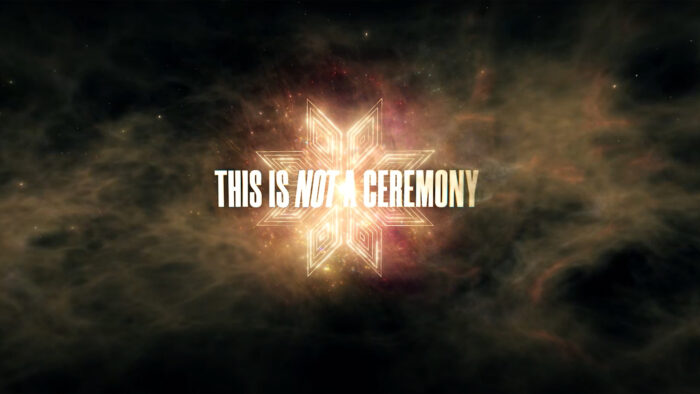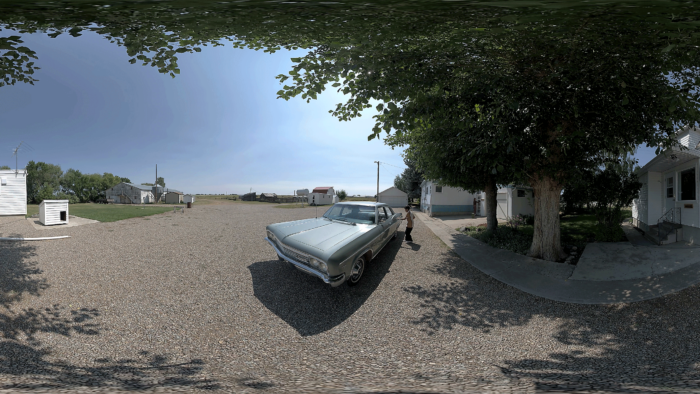
This is not a Ceremony
21 min
Licensing

You’re invited to witness an unforgettable cinematic experience, guided with care and kindness by tricksters, matriarchs and buffalo as you confront some of the darker sides of living life in Canada while Indigenous.
THIS IS NOT A CEREMONY is a cinematic dome experience by Niitsitapi writer and director Ahnahktsipiitaa (Colin Van Loon). It takes viewers beyond traditional media, immersing them in a realm where past, present, and future converge, and where colonial assumptions are cast aside. In this dream-like world, two Indigenous trickster poets, dressed in mirrored red suits, guide us through narratives that challenge our notions of personal responsibility while exploring the darker realities of Indigenous life in Canada. Matriarchs and Inii (buffalo) lead us with firm yet kind hands, confronting us with the harsh truths of systemic racism and colonial oppression. The experience ultimately asks, “Now that you know, what will you do about it?” THIS IS NOT A CEREMONY is a powerful, unforgettable journey that urges us to bear witness, learn from these stories, and never forget.
AWARDS AND FESTIVALS
⎯⎯⎯⎯⎯⎯⎯⎯⎯⎯⎯⎯⎯⎯⎯⎯⎯⎯⎯⎯⎯⎯⎯⎯⎯⎯
- BEST FULLDOME INNOVATION | Jena Fulldome (2025)
- OFFICIAL SELECTION | Macon Film Festival (2025)
- OFFICIAL SELECTION | Jena Fulldome (2025)
- OFFICIAL SELECTION | Brno Fulldome 2025
- OFFICIAL SELECTION | Sundance Film Festival, Canada (2022)
- OFFICIAL SELECTION | Tribeca Film Festival, États-Unis (2022)
- OFFICIAL SELECTION | Calgary International Film Festival, Canada (2022)
- OFFICIAL SELECTION | Festival du Nouveau Cinema, Canada
- OFFICIAL SELECTION | imagineNATIVE Film & Media Arts Festival, Canada
- OFFICIAL SELECTION | Vancouver Internation Film Festival, Canada
DIRECTOR STATEMENT
⎯⎯⎯⎯⎯⎯⎯⎯⎯⎯⎯⎯⎯⎯⎯⎯⎯⎯⎯⎯⎯⎯⎯⎯⎯⎯
From the moment I began working on THIS IS NOT A CEREMONY, I knew we had a mission. Working with incredible Indigenous storytellers and top-of-the-line technology, I wanted to create an unforgettable VR experience that would allow audiences to participate in the Blackfoot tradition of bearing witness, to confront some of the darker realities of being an Indigenous person living in Canada.
My goal was to break through the barrier of being the Other and get audiences to feel closer with the Indigenous men portrayed in the film’s two stories of colonial injustice—to create a connection that goes deeper than tragic headlines. I wanted this virtual experience to have more than just audiences: I wanted it to create witnesses.
To engage somebody as a witness is a real responsibility, and it becomes their responsibility to repeat what they’ve seen and heard. The hope is that people will take this knowledge and carry it forward. I think that when people have this knowledge, they feel compelled to do something about it.
I’ve always had an interest in documentary film and the expressive and imaginative ways it can convey real-world issues. For me, virtual reality (VR) was the perfect way to create a story that was both informative and captivating.
It’s so different from just watching a square screen. Your body responds to it. You feel like you experience things. You don’t always have a choice; sometimes you just feel this kind of psychosomatic response. You feel very present and aware.
The whole method of filmmaking had to be rethought in order to record the film in 360 degrees, as the crew could not hide “behind the camera,” so as a result, they had to get creative to record scenes.
Over the project’s development, two cast members tragically passed away: poet Taran Kootenhayoo and Indigenous community leader Lillian Howard. This has been a tremendous loss, personally and for the Indigenous community, and I hope this film can help us honour their memories and the stories they share in presenting, as we watch, experience and bear witness.
CREDITS
⎯⎯⎯⎯⎯⎯⎯⎯⎯⎯⎯⎯⎯⎯⎯⎯⎯⎯⎯⎯⎯⎯⎯⎯⎯⎯
Written and Directed by
Ahnahktsipiitaa (Colin Van Loon)
Produced by
the National Film Board of Canada
In partnership with
imagineNATIVE Film + Media Arts Festival
Featuring
Adam North Peigan
Robert Sinclair
Poets
Taran Kootenhayoo
Tawahum Bige
Matriarch Guide
Lillian Howard
Director of Photography
Olivier Leroux
Editor
Jessica Dymond
Art Director
James Monkman
Music
Nagamo Publishing
Nigel Irwin
Sound Design & Mixing
Nagamo Publishing
Drew Snyder
Assistant Director
Rob Guthrie
Production Designer
Sean McQuillan
Location Scouts
Michelle Bond (BC)
Quentin Johnston (Alberta)
FEATURED CAST
⎯⎯⎯⎯⎯⎯⎯⎯⎯⎯⎯⎯⎯⎯⎯⎯⎯⎯⎯⎯⎯⎯⎯⎯⎯⎯
Brian Sinclair – David Lyle
Nurse – Marlies Dubois
Orderly – Arvind Johal
Security Guard – Otto Szabo
Social Worker – Michele Wienecke
Young Adam – Alexander Eagletail
Background Performers
Jamie Crozier
Donna Kodama
Leanna Nash
Mustafa Yilmaz
Montana Oglesby
Blackfoot Voiceover and Translation
Dr. Eldon Yellowhorn
Portrait photography by
Alanna Blackrider - Onespot
Portrait Subjects
Adonis ManyChief
Zane Severite-ManyChief
Adonis Zaharjko
Billy Twigg
Leonard Little Mustache Jr.
Dakota Big Tobacco
Draytin Morden
Justin Meguire
Donald Saddleback
Everett Wolftail
Jonathan Brewer
Brody Bad Eagle
Nathan Avery
Herb Wilson
Kobe Alexander James Morning Bull
Dwayne Delaney
Brayson Breaker
Liam Breaker
Keeran Yellow Horn
Jayden Doore
Earnest Poundmaker
Montana Tyrell Redcalf
Danzel Ear
George Goodstriker
Daniel Pard
Tristen Beebe
Bobby Currie
Joseph Rex Across the Mountain
George Van Loon
James Across the Mountain
Gaffer
Cameron Watts
Grip
Torin Greyeyes-Starblanket
Sound Recordists
Tyler Lucas (BC)
Zack May (Alberta)
Wardrobe
Carmen Thompson
Wardrobe Assistants
Karuna Breeze Dampsy
Emmy Routledge
Hair and Makeup
Keesha Dawson-Harrison (BC)
Min Jee Mowat (BC)
Chenise Soosay (Alberta)
Set Photography
Soloman Chiniquay (BC)
Alanna Blackrider-Onespot (Alberta)
Data Wranglers
Odessa Shuquaya (BC)
Adam Solway (Alberta)
Property Buyer
Heather McQuillan
Community Liaison
Tawnya Plain Eagle
Production Assistants
Dustin McGladrey (BC)
Richard Wilson (BC)
Charlene Parsons (BC)
Kahka-Naikitstakii Crop Eared Wolf (Alberta)
Assistant Editor
Michael Morin
3D Animator
Brian Vowles
Kodai Yanagawa
French Translation
Gabrielle Lisa Collard
Craft Services
Salishan Catering
NATIONAL FILM BOARD OF CANADA - TEAM
⎯⎯⎯⎯⎯⎯⎯⎯⎯⎯⎯⎯⎯⎯⎯⎯⎯⎯⎯⎯⎯⎯⎯⎯⎯⎯
Producer
Dana Dansereau
Executive Producer
Robert McLaughlin
Project Manager
Laura Mitchell
Senior Production Coordinator
Jasmine Pullukat
Creative Technologist
Vincent McCurley
Studio Operations Managers
Camille Fillion
Janine Steele
Studio Administrators
Victoria Angell
Carla Jones
Marketing Manager
Tammy Peddle
Marketing Coordinator
Eric Bondo
Social Media Strategist
Hannah Martin
Education Marketing Strategist
Anne Koizumi
Publicist
Jennifer Mair
Katja De Bock
Legal Counsel
Christian Pitchen
IMAGINENATIVE FILM + MEDIA ARTS FESTIVAL TEAM
⎯⎯⎯⎯⎯⎯⎯⎯⎯⎯⎯⎯⎯⎯⎯⎯⎯⎯⎯⎯⎯⎯⎯⎯⎯⎯
Executive Director
Naomi Johnson
Executive Director
Jason Ryle
Institute Director
Daniel Northway-Frank
SPECIAL THANKS
⎯⎯⎯⎯⎯⎯⎯⎯⎯⎯⎯⎯⎯⎯⎯⎯⎯⎯⎯⎯⎯⎯⎯⎯⎯⎯
Reba Rose DeGuevara
Edit Van Loon
Van Loon Family
Jimmy and Joanne Small Legs & Small Legs Family
Philip & Joanne Wolfchild
Jonathan Brewer, Kathy Brewer and Brewer Family
Harry Nose Clan
North Peigan Family
PIIKANI NATION CHIEF AND COUNCIL
⎯⎯⎯⎯⎯⎯⎯⎯⎯⎯⎯⎯⎯⎯⎯⎯⎯⎯⎯⎯⎯⎯⎯⎯⎯⎯
Chief Stanley Grier
Councillor Erwin Bastien
Councillor Wesley Crow Shoe
Councillor Che Little Leaf-Matusiak
Councillor Riel Provost-Houle
Councillor Doane Crow Shoe
Councillor Brian Jackson
Councillor Troy (Bossman) Knowlton
Councillor Theodore (Terry) Provost
Percy Bullchild & Bullchild family
Thank you Percy for all of the wonderful words and the stories you wrote down for all of us niitsitapi. Your book is a constant source of inspiration, guidance and wisdom.
Indigenious Matriarch 4 VR/VR (IM4-LAB)
Emily Carr University of Art + Design
Vancouver Film School
BC Housing
Blackfoot Nation Films
Joan Ralph
Jeff Bullock
Calvin Sosick
Southern Alberta Vintage & Classic Car Club
Provost family
Margo Kane
Loretta Todd
Doreen Manuel
Cease Wyss
Tracey Kim Bonneau
Alannah Mandamin
Cheyanna J. V. Kootenhayoo (djKookum)
Kootenhayoo Family
Trevor Solway
George Van Loon
North Van Loon
Oveta, Dan & Roy Kennedy
Leanne Rooney
Robyn Weasel Bear
Jay Cardinal Villeneuve
Ken Tsui
Lizzy Karp
Tug Phipps
Shirley Vercruysse
THIS IS NOT A CEREMONY WAS CREATED
⎯⎯⎯⎯⎯⎯⎯⎯⎯⎯⎯⎯⎯⎯⎯⎯⎯⎯⎯⎯⎯⎯⎯⎯⎯⎯
in Alberta on the traditional territories of the Blackfoot Confederacy (Piikani (Brocket) Siksika, Kainai (Bloods), and Amskapi Piikani (Montana / Browning), the Tsuut’ina, the Îyâxe Nakoda Nations, the Métis Nation (Region 3), and all people who make their homes in the Treaty 7 region of Southern Alberta;
in Vancouver on the unceded territories of the xʷməθkʷəy̓əm (Musqueam), Sḵwx̱wú7mesh (Squamish), and Sel̓íl̓witulh (Tsleil-Waututh) Nations;
in Coquitlam on the core territory of the kʷikʷəƛ̓əm (Kwikwetlem) (Kwee-kwet-lem) First Nation and lies within the shared traditional territories of the Tsleil-Waututh (Slay-wa-tuth), Katzie (Kate-zee), xʷməθkʷəy̓əm (Musqueam), Sḵwx̱wú7mesh Úxwumixw (Squamish), Quay Quayt (Key-Kite) First Nation and Sto:lo Nation
LONG SYNOPSIS
⎯⎯⎯⎯⎯⎯⎯⎯⎯⎯⎯⎯⎯⎯⎯⎯⎯⎯⎯⎯⎯⎯⎯⎯⎯⎯
Niitsitapi writer and director Ahnahktsipiitaa (Colin Van Loon) takes us beyond the veil of traditional media and transports us directly into another realm, where past, present and future are one; where colonial rules and assumptions are forgotten; and where we can finally get to the truth of the matter.
In this stunning, cinematic VR experience, we’re invited to watch as the narrative unfolds all around us, on a dream-like plane of existence where spirits and time flow and merge, and stories come to life and dance before our eyes. Inside this immersive virtual world, two Indigenous trickster poets in mirrored red suits and long braids guide us on a journey, in which community protocols confront our notions of personal responsibility. The pair’s sharp wit and caustic humour will be familiar to anyone who has spent time in First Nation communities, and their comradery keeps us at ease as we explore some of the darker sides of living life in Canada while Indigenous.
Matriarchs and Inii (buffalo) rule this virtual realm. They pull no punches, yet they lead us with kindness, bringing us face-to-face with some of the grim realities Indigenous Peoples have experienced. We explore the stories of two Indigenous men wounded by the colonial tradition of systemic racism. These stories disrupt the status quo, laying bare the benign cruelty of colonial oppression, and dare to ask, “Now that you know, just what are you going to do about it?”
This unforgettable experience will stay with you long after it’s over. Challenging us to act on what we’ve learned, THIS IS NOT A CEREMONY calls on all who’ve watched to bear witness and share what they’ve seen and heard, to learn from these tragedies—and to never forget.
Q & A
⎯⎯⎯⎯⎯⎯⎯⎯⎯⎯⎯⎯⎯⎯⎯⎯⎯⎯⎯⎯⎯⎯⎯⎯⎯⎯
How did you come to share Adam North Peigan’s and Brian Sinclair’s stories?
Colin: Adam is my relative and as we were talking, I realized that this is a good story. I don’t know if you know much about his professional career, but he does a lot of advocacy around the Sixties Scoop. He was keen to share because of the work he does.
Then the Brian thing was just so horrific that we had to find a way to tell it. We talked to a bunch of different people in the family, then Robert, he says it in the film: ‘I live there in Winnipeg, I have to go to that hospital. My son was in the hospital just before this happened to Brian, and then I have grandchildren and they’re going to go there.’ He wanted to have some impact.
What was the inspiration behind the making of THIS IS NOT A CEREMONY?
Colin: There are these things that happen in the news every once in a while, and it’s just dumbfounding, like, how the hell does this happen? How the hell does this man, Brian Sinclair, go to the hospital and die in the waiting room?
With Adam, we just talk about this moment where the social worker knows that this boy [Adam] is being abused. They take him out of the house, they walk him across the yard, as if that would be safer.
Then the poets; I was always close with Taran [who has since passed away] and thought he was brilliant. I thought, if we’re going to do this and we’re going to bring people closer to these people and these stories, why don’t they also witness? Why don’t they witness, and we could see how they feel about it?
How does the title, THIS IS NOT A CEREMONY, relate to those stories?
Colin: So we were looking for a title and I was thinking about the impacts of getting somebody to be a witness and what that kind of responsibility is.
At some point it became clear that that was the title, and also, the poets, they said it when they were doing their poems: ‘This is not a ceremony, this is a tradition. And this is Canada’s tradition. This is Canada’s tradition of systematic racism.’
We were going to call it, at one point, Can I Get a Witness?, like James Brown or something: ‘Can I get a witness? Hey.’
What do you hope the audience that watches this film takes away from this message? And who is this film meant to be for?
Colin: I hope that people take their job seriously, their job as a witness. Then I think that this is always for Indigenous people to see, so that they can be aware of these stories, but also, that they can champion these people. That’s why the end is more upbeat. This is also for settlers, Napikwans, like, get your shit together.
Was this film initially made specifically for VR? Or was it a stylistic choice that you made?
Colin: I think it’s both. If you watch this on a different screen, it doesn’t have the same effects. I just think that if we want to get closer to these people and their stories, VR has this power of being present in those moments. You feel like you’re there. I think that if we were to watch Taran and Tawahum doing their spoken-word piece [on a small screen], we just couldn’t feel that in the same way.
When they come up to you and they’re very close to you, it really has an impact on the way you feel as the person viewing it. I want people to feel uncomfortable and I want them to take that uncomfortability and think about it.
Was your first project in VR? And would you do another one like this?
Colin: Yeah, but probably not for a while. I’m going to need a little break. This is the medium for this story, but maybe a different story requires something else.
So Dana, maybe talk about your experience working on this film and having to delve into these kinds of stories.
Dana: As a settler, as a white dude who is part of a committee who worked with imagineNATIVE on deciding the potential story… we came across Colin’s, and it was raw but beautiful, you could feel the energy in it. At the time it was called Walk a Mile in My Moccasins. And—
Colin: Such a bad title. That title was never meant to stay.
Dana: But the concept was there, and it was already confronting the idea of what happens when you put someone in a situation in virtual reality? What does it say about virtual reality? What does it say about the story you’re doing? To this day, it’s a little lovely and messy, where there’s no perfect… even in the title, THIS IS NOT A CEREMONY—but it is a ceremony, but it’s not a ceremony, so it bounces back and forth constantly. Virtual reality is always doing that, and so we saw that in Colin’s proposal. Then we met Colin, and it was just like, ‘Oh, man, this is the person to do this with.’
What did the participants think of the final piece?
Dana: When we talked with Adam, I think he felt Colin really captured what he’s trying to say and that framing it in this way has given it a nice, new, impactful way of being presented. He’s told this story [before] but it’s not a story that’s been represented this way. We haven’t talked with Robert yet, but he did text me saying he found it very emotional.
Why was it important to have an Indigenous crew working on the film?
Colin: We don’t have enough film crew generally; there are lots of directors, but there’s not a lot of specific crew roles, like editors, colourists, sound designers. There are some people who are okay at a couple of things, but there’s not a lot of people who are really amazing at one thing.
I want to always support that, for both cultural reasons, we need that, so we don’t have to navigate this cultural divide, but selfish reasons also.
Dana: Yeah, it takes from the NFB perspective as well, supporting those crafts, the vast array of people that are needed to make films. We want, just like Colin, talent development and to support as many people as possible.






Ahnahktsipiitaa (Colin Van Loon)
Screenwriter and director
Of Dutch and Pied-Noir descent, filmmaker Ahnahktsipiitaa is a member of the Piikani Nation. He was raised by his mother in Lethbridge, as well as in several small towns across southern Alberta. Today, he serves as Director of Operations at the Indigenous Matriarchs 4 AR/VR Media Lab (IM4-Lab) and is a member of Telefilm Canada’s Indigenous Working Group. Deeply committed to his community, he works to uplift Indigenous voices and stories—whether by supporting emerging artists through the REEL Reservations: Cinematic Indigenous Sovereignty series presented at the Talking Stick Festival, or through his production company, Blackfoot Nation Films.
Jessica Daymond
Editor
With over ten years of experience in media arts, Jessica Dymond specializes in editing a wide range of projects, from experimental documentaries to television series and narrative films. Her work has been featured at numerous prestigious festivals, including Hot Docs, imagineNATIVE, DOXA, LA Skins Fest, and the Banff Mountain Film Festival. She holds a Master of Fine Arts from X University (formerly Ryerson University), a Graduate Diploma in Communication Studies from Concordia University, and a Bachelor of Arts from McGill University. At the end of her academic journey, she honed her video editing skills through an internship at the Banff Centre. In 2017, she also participated in the Whistler Film Festival’s Doc Lab program.


James Monkman
Artistic director and visual effects
James Monkman, a Cree art director and visual artist, lives in Toronto, Ontario, with his partner and their children. Originally from Winnipeg, Manitoba, he was raised at the intersection of Indigenous and Western cultures—a dual grounding that continues to shape and inspire his artistic work. His practice is rooted in a deeply Indigenous approach, which forms the core of his creative process. Working across a variety of tactile and digital media, he explores themes drawn from traditional Indigenous thought, cosmology, and language, while projecting them into a vision firmly grounded in Indigenous futurism. Through this unique perspective, he seeks to emphasize the vital importance of Indigenous worldviews within a continually evolving North American culture.
Nagamo Publishing
Music and sound design
Founded in 2019, Nagamo was born out of a desire to make truly Indigenous production music accessible. By collaborating with a broad network of Métis, Inuit, and First Nations composers, the company offers high-quality music that is authentically rooted in Indigenous cultures. After establishing its presence across Canada, Nagamo is now expanding its network throughout Turtle Island, with the goal of reaching international markets. The company offers both custom compositions and a rich catalog of licensable works. Whether creating a subtle atmosphere, emphasizing a moment of tension, or supporting a dynamic scene, Nagamo brings each image to life with a soundtrack that is both authentic and refined.


